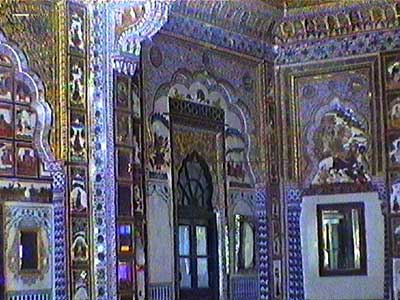JODHPUR (Day 6)
Like every major desert city, Jodhpur also had a giant fort. Mehrangarh Fort was started in 1459 by local leader Rao Jodha. It was a very long uphill climb through some massive doors but eventually we arrived at the top.
We walked along the outer defensive wall (the ramparts) from which we had a great view of the 'blue' city. It was indeed quite blue. In the old days, members of the higher castes used to paint their houses blue to distinguish them from the lower caste white houses. It was amazing how the sound was carried up on the wind and one could hear everything, including individual noises and voices.


Caution had to be taken along certain parts of the wall in that there were no fences to prevent one from just walking off the edge.. and it was long way down. Perhaps that explained all the vultures that circled overhead.
The complex was very large and there were many courtyards. Many spectacular rooms filled with gold and mirrors as well as marvelous stone carved facades greeted us at every turn. Several sections of the fort had been converted into museums. The turban museum showed all the practical uses of a turban (to store stuff in, to get water from a well, to lead a camel, etc) and also had the 'color of month'. There was also an elephant carriage museum, a treasury filled with swords, and a pearl palace (there were no real pearls but mirrors reflected the candlelight to look like some). Many of these rooms were originally only for men; women were given a separate area with the eunuchs. We learned that one particular maharaja married 30 women in one year.



A dexterous chipmunk


We would have like to stay longer but had apparently overbooked this trip, trying to fit too many places into too little time. We set out on the long drive to Jaipur. Along the way, we saw lots of traffic accidents. The first involved a passenger bus. The front right side was totaled but we couldn’t tell what it had hit. Another was a truck on its side. The next was a small truck was completely smashed in front from hitting a large truck. The main reason that India has such a high auto fatality rate is not due to the large number of accidents, but rather due to the large number of people squished into each vehicle.
As always, we made our usual chai stop at some dingy roadside stand. One young boy was convinced that I was a man because I wore pants and that my hair was not covered. He just found it very odd that I didn't have any signs of a beard.
At one point, we encountered a massive traffic jam. Apparently they were repairing one lane and the traffic was backed for miles on both sides. We drove on the wrong side of the street until oncoming trucks kept pushing us out of the way. Then we joined some other cars and drove on the shoulder until we reached the bridge where the bottleneck was. We watched an all-terrain vehicle drive through the river and for a moment Mukesh had the idea to try to cross as well, but it was far too muddy and deep. He eventually convinced two trucks to let him through to the other lane and we squeezed through with mere centimeters to spare. Once we crossed the bridge, traffic was moving again... of course the other direction sat backed up for miles. Many cars and busses had simply pulled to the side of the road to wait it out, occupying their time by eating, praying, etc.


On the road to Jaipur (in India they drive on the left) ... Squeezing past the trucks on the dirt shoulder
Since Mukesh continued to drive like a bat out of hell and constantly passed without regard for the safety of others, it was inevitable that eventually he was going to piss somebody off. The somebody in this case, however, was a cop who just happened to be traveling through the area (so with no jurisdiction). Technically all he could do was yell and scream, which he did plenty of.
At this point into the trip, our horn had dead and we could only relying on using our 'dippers' (headlights). But it's much harder to drive without a horn because people don’t look at all before walking into the street. We almost completely plowed over one old woman.
We arrived in Jaipur, the "pink city" at 8:30 pm. True to its nickname, all the houses and entrance gates were painted pink (well, more orange actually). The city was founded in 1727 by Maharaja Jai Singh II (from whom it got its name). The pink color was meant to create the impression of red sandstone buildings of cities of the Mughal Empire.
Our hotel room was fine. It was clean and relatively quiet. We took the opportunity to watch some Indian tv. It was very bizarre combination of English and Hindi; they just randomly switch languages mid-sentence.
return • continue

